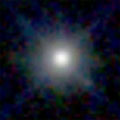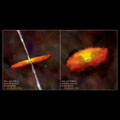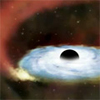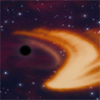CXC Home | Search | Help | Image Use Policy | Latest Images | Privacy | Accessibility | Glossary | Q&A
1. Focus on Black Holes in the Chandra Deep Field-North
QuicktimeMPEG This sequence demonstrates how X-rays are needed to find black holes. Beginning with the Chandra Deep Field-North, the view zooms into an X-ray close-up of a black hole over 10 billion light years away. When it dissolves into an optical image, the host galaxy is clearly bright in the center indicating the presence of a growing black hole. On the other hand, a relatively nearby black hole is bright in X-ray light, but an optical image looks like a "normal" spiral galaxy. Therefore, this black hole would have been missed without the X-ray information.
[Runtime: 0:15]
(Animation: X-ray image: NASA/CXC/PSU/D.M.Alexander, F.E.Bauer, W.N.Brandt et al.; Optical image: NASA/ESA/The GOODS Team)
Related Chandra Images:
QuicktimeMPEG This sequence demonstrates how X-rays are needed to find black holes. Beginning with the Chandra Deep Field-North, the view zooms into an X-ray close-up of a black hole over 10 billion light years away. When it dissolves into an optical image, the host galaxy is clearly bright in the center indicating the presence of a growing black hole. On the other hand, a relatively nearby black hole is bright in X-ray light, but an optical image looks like a "normal" spiral galaxy. Therefore, this black hole would have been missed without the X-ray information.
[Runtime: 0:15]
(Animation: X-ray image: NASA/CXC/PSU/D.M.Alexander, F.E.Bauer, W.N.Brandt et al.; Optical image: NASA/ESA/The GOODS Team)
Related Chandra Images:
- Photo Album: Lockman Hole
2. Illustrations of Disks around Black Holes
QuicktimeMPEG Broadcast:
These two illustrations show the difference between the very biggest supermassive black holes in the Universe and relatively smaller ones. In each case, the black hole is swallowing large amounts of gas from a surrounding disk. The first illustration is of a black hole with a mass between about 10 million and 100 million Suns. Here, the central black hole is obscured by a thick donut-shaped cloud of dust and gas. The second shows the growth of a larger black hole, with a mass greater than 100 million Suns. This black hole is surrounded by much a thinner torus of dust and gas.
[Runtime: 0:12]
(NASA/CXC/M.Weiss)
Related Chandra Images:
QuicktimeMPEG Broadcast:
- QuickTime movie (uncompressed)
- D1 (0.9 pixel aspect ratio)
- 720x486
- 29.97 fps
- file size = (52.2 MB)
These two illustrations show the difference between the very biggest supermassive black holes in the Universe and relatively smaller ones. In each case, the black hole is swallowing large amounts of gas from a surrounding disk. The first illustration is of a black hole with a mass between about 10 million and 100 million Suns. Here, the central black hole is obscured by a thick donut-shaped cloud of dust and gas. The second shows the growth of a larger black hole, with a mass greater than 100 million Suns. This black hole is surrounded by much a thinner torus of dust and gas.
[Runtime: 0:12]
(NASA/CXC/M.Weiss)
Related Chandra Images:
- Photo Album: Lockman Hole
3. Comparison of Obscured AGN Spectrum and XMM Spectrum
QuicktimeMPEG Broadcast:
This sequence of illustrations begins by showing an active galactic nucleus (AGN), a supermassive black hole that is swallowing large amounts of gas via a disk. In the type of AGN shown here the central black hole is obscured by a thick donut-shaped cloud of dust and gas. A representation of the X-ray spectrum, or X-ray energy signature, of a typical obscured AGN is then shown in yellow, followed by the XMM spectrum of the event in RX J1242-11 (shown in blue). The clear difference between the obscured AGN spectrum and the XMM spectrum shows that RX J1242-11 is not an obscured AGN. An optical spectrum obtained earlier with HST rules out the possibility that RX J1242-11 is a "normal" AGN, where the nucleus containing the black hole is not obscured by dust and gas.
[Runtime: 0:14]
(Spectrum: ESA/XMM-Newton/S.Komossa et al.; Illustration: NASA/CXC/M.Weiss)
Related Chandra Images:
QuicktimeMPEG Broadcast:
- QuickTime movie (uncompressed)
- D1 (0.9 pixel aspect ratio)
- 720x486
- 29.97 fps
- file size = (43 MB)
This sequence of illustrations begins by showing an active galactic nucleus (AGN), a supermassive black hole that is swallowing large amounts of gas via a disk. In the type of AGN shown here the central black hole is obscured by a thick donut-shaped cloud of dust and gas. A representation of the X-ray spectrum, or X-ray energy signature, of a typical obscured AGN is then shown in yellow, followed by the XMM spectrum of the event in RX J1242-11 (shown in blue). The clear difference between the obscured AGN spectrum and the XMM spectrum shows that RX J1242-11 is not an obscured AGN. An optical spectrum obtained earlier with HST rules out the possibility that RX J1242-11 is a "normal" AGN, where the nucleus containing the black hole is not obscured by dust and gas.
[Runtime: 0:14]
(Spectrum: ESA/XMM-Newton/S.Komossa et al.; Illustration: NASA/CXC/M.Weiss)
Related Chandra Images:
- Photo Album: RX J1242-11
4. Illustrations Explaining Tidal Disruption
QuicktimeMPEG Broadcast:
The first illustration in this sequence shows a doomed star (orange circle) that wanders so close to a giant black hole that the black hole's enormous gravity stretches the star until it is torn apart. Some of the disrupted star's mass (indicated by the white stream) is swallowed by the black hole, while the rest is flung away into the surrounding galaxy. The second illustration shows how the gas that was pulled towards the black hole forms a disk and is heated before being swallowed by the black hole. The third illustration shows a much fainter disk, after about ten years have elapsed, when most of the gas has been swallowed by the black hole.
[Runtime: 0:12]
(NASA/CXC/M.Weiss)
Related Chandra Images:
QuicktimeMPEG Broadcast:
- QuickTime movie (uncompressed)
- D1 (0.9 pixel aspect ratio)
- 720x486
- 29.97 fps
- file size = (117.8 MB)
The first illustration in this sequence shows a doomed star (orange circle) that wanders so close to a giant black hole that the black hole's enormous gravity stretches the star until it is torn apart. Some of the disrupted star's mass (indicated by the white stream) is swallowed by the black hole, while the rest is flung away into the surrounding galaxy. The second illustration shows how the gas that was pulled towards the black hole forms a disk and is heated before being swallowed by the black hole. The third illustration shows a much fainter disk, after about ten years have elapsed, when most of the gas has been swallowed by the black hole.
[Runtime: 0:12]
(NASA/CXC/M.Weiss)
Related Chandra Images:
- Photo Album: RX J1242-11
5. Comparison of X-ray to Optical Data
QuicktimeMPEG Broadcast:
This image sequence begins with an earlier X-ray (ROSAT satellite) image of the source RX J1242-11 when astronomers saw it in its brightest state. Next, the sequence zooms into a smaller region at the center, before merging to a Chandra image of RX J1242-11. Obtained 9 years later, the Chandra image shows that the source is 200 times fainter, a characteristic of a torn apart star near a black hole. The sequence then dissolves to an optical image of the same field. The white circle shows the position of the Chandra source on the visible-light image, proving this event occurred in the center of RX J1242-11.
[Runtime: 0:10]
(ROSAT image: MPE; Optical: MPE/S.Komossa; Chandra: NASA/CXC/MPE/S.Komossa et al.)
Related Chandra Images:
QuicktimeMPEG Broadcast:
- QuickTime movie (uncompressed)
- D1 (0.9 pixel aspect ratio)
- 720x486
- 29.97 fps
- file size = (17.3 MB)
This image sequence begins with an earlier X-ray (ROSAT satellite) image of the source RX J1242-11 when astronomers saw it in its brightest state. Next, the sequence zooms into a smaller region at the center, before merging to a Chandra image of RX J1242-11. Obtained 9 years later, the Chandra image shows that the source is 200 times fainter, a characteristic of a torn apart star near a black hole. The sequence then dissolves to an optical image of the same field. The white circle shows the position of the Chandra source on the visible-light image, proving this event occurred in the center of RX J1242-11.
[Runtime: 0:10]
(ROSAT image: MPE; Optical: MPE/S.Komossa; Chandra: NASA/CXC/MPE/S.Komossa et al.)
Related Chandra Images:
- Photo Album: RX J1242-11
6. Animation of Star Ripped Apart
QuicktimeMPEG Broadcast:
This animation shows a yellow star that travels too close to a giant black hole in the center of the galaxy RX J1242-11. As it nears, the star is stretched by tidal forces from the black hole and is quickly torn apart. Most of the yellow gaseous debris from the star escapes the black hole in parabolic orbits. However, a small amount of material is captured by the black hole and then forms a rotating disk of gas. X-rays are emitted as the gas in the disk is heated (as shown by the blue color) and is gradually swallowed by the black hole, eventually emptying the disk.
[Runtime: 0:43]
(ESA)
Related Chandra Images:
QuicktimeMPEG Broadcast:
- QuickTime movie (uncompressed)
- D1 (0.9 pixel aspect ratio)
- 720x486
- 29.97 fps
- file size = (1 GB)
This animation shows a yellow star that travels too close to a giant black hole in the center of the galaxy RX J1242-11. As it nears, the star is stretched by tidal forces from the black hole and is quickly torn apart. Most of the yellow gaseous debris from the star escapes the black hole in parabolic orbits. However, a small amount of material is captured by the black hole and then forms a rotating disk of gas. X-rays are emitted as the gas in the disk is heated (as shown by the blue color) and is gradually swallowed by the black hole, eventually emptying the disk.
[Runtime: 0:43]
(ESA)
Related Chandra Images:
- Photo Album: RX J1242-11








